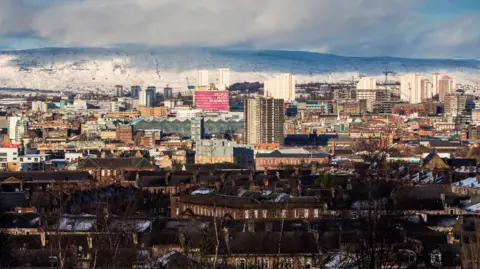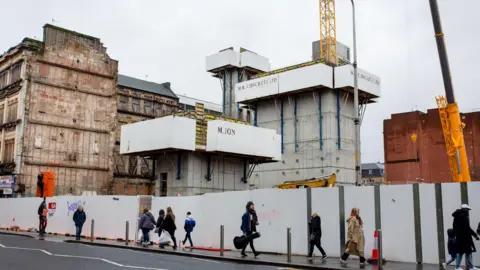Jonathan Geddes
BBC Glasgow and West reporter

 Getty Images
Getty Images
Glasgow's skyline could change after a new tall buildings policy was introduced
Think of skyscrapers and images come to mind of New York City's skyline, or hundreds of buildings soaring above the streets of Hong Kong.
But could Glasgow be poised for a similar boom in tall buildings?
The city council formally approved its new tall buildings policy on Thursday, with a design guide establishing what areas could benefit from construction, such as Charing Cross and Cowcaddens.
The local authority hope the plans would lure more developers to the city, building upwards and therefore creating more accommodation and also space for businesses - at a time when land for development is becoming limited.
It's a strategy other cities in the UK have pursued in recent years, with London and Manchester building clusters of skyscrapers at pace.
BBC Scotland News understands the hope from some in the city council is that the new policy would shatter misconceptions regarding Glasgow having limits on building heights, and therefore encourage more interest from developers.
At the moment the city's tallest building - the tower at the Science Centre by the River Clyde - is under the minimum height for a skyscraper, which is taller than 150m. It sits at 127m.
Work began last year on the Ard development in Blythswood Hill, a 36-storey tower of student accommodation. But some of the city's tall buildings already lie vacant, while large blocks of flats - like on Wyndford Road - have been demolished in recent years.
Plans to redevelop the 14-storey Met Tower as a digital tech hub were cancelled last year.


The Met Tower would be classed as a metropolitan building under the new guidelines
The new design guide doesn't set sights quite so high, defining tall buildings via various factors - including how it's perceived on street level and how it affects the skyline around it.
The highest category - metropolitan - is classed as a building three and a half times above the height of "the broader context" surrounding it, meaning somewhere like the Met Tower.
Architect Gerry Hogan, who works with the firm Collective Architecture, believes the policy is quite conservative, but welcome nonetheless.
"We've been a little reticent to be bold with in our approach to tall buildings, and arguably with architecture in Glasgow generally," he says.
"If anything, the guide doesn't go far enough – they go through a very careful analysis of where tall buildings should be located and it doesn't give much encouragement for parts of the city."

 Reuters
Reuters
Skyscrapers in London tend to be clustered together
That belief is centred on the guide's suggestion on placing larger spaces - ideally mixed-use developments with shops or leisure facilities below housing - in certain parts of the city, therefore avoiding clashes with conservation areas like Pollok Park.
Russell Baxter, a director with architecture and engineering firm NORR, believes the guide encourages clusters of buildings together.
"If you look at London, there's a lot of clusters there," he says.
"It has a very protected skyline, so things like cathedrals and churches are retained, and key views are retained – that's everything in these cities.
"So in Glasgow something like Trinity Tower at Park Circus is a key view – you can't obliterate that view for people. The idea is to cluster them together so you get a number of them in one area - the edge of the motorway is always seen as a place where that can happen."

 Getty Images
Getty Images
The Trongate is an area the document suggests as suitable for tall buildings
Mr Hogan believes that the quality of the new builds themselves will be key to making them a success, wherever they are situated in the city.
"A tall building is the same as any building, it comes down to how good it is," he explains.
"Sure, height is a factor but if it's well designed and how it sits in the skyline has been considered then there's no reason it couldn't be put in more sensitive areas if they were well enough designed.
"What this seeks to promote, and what I agree with, is having multi-use buildings that bring in people throughout the day and engage people in using both the building and the wider area around it.
"You don't want it putting a nearby park in the shade for example."
'You have to justify these buildings'
Cllr Ruairi Kelly, the convener for development and land use at Glasgow city council, said the proposals will play a "significant role in our ambition to grow the city centre population" through providing a housing boost.
However Manchester's recent boom in tall buildings was driven by public money, in particular the £300m Greater Manchester Housing Investment Fund.
Instead Glasgow will have to box clever, including with locations.
"You've not got the ability to do what you could do in Victorian times where you could just place a church or town hall at the end of a street, like a church being right on Ingram Street," says Mr Baxter.
"If you go down Buchanan Street and the way the station entrance is sitting there – those were classic Victorian moves for how you masterplan cities and those buildings were key public buildings.
"Now what you get are all buildings that are full of students and you have to justify them taking up these key positions."
The guidance itself was drawn up through a public consultation and feedback from designers, developers and amenity organisations.
Mr Baxter believes the guidance will be helpful, even if the city having its own version of the Burj Khalifa remains a pie in the sky thought for now.
"At the end of the day, you're not going to stop developers building tall. So what you need to do is control it, and that's what the policy is there to do – control where they are and control the quality of them."

 3 hours ago
2
3 hours ago
2









